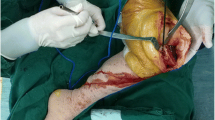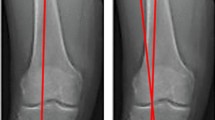Abstract
Purpose
The current study aimed to evaluate how open-wedge high tibial osteotomy (OWHTO) without the release of medial collateral ligament (MCL) changes in vivo intra-articular joint space after the surgery.
Methods
Patients with varus malalignment of the knee with an indication for OWHTO were included in this study. The intra-articular gap was measured before and 30 min after OWHTO without MCL release using a series of calibrated nerve hooks. The association of post-operative gap size with varus angle, medial proximal tibial angle (MPTA), lateral distal femoral angle (LDFA) and joint line convergence angle (JLCA) was also assessed.
Results
A total of 42 knees from 38 patients were evaluated. The mean size of the intra-articular gap of the medial compartment was 5.2 ± 1 mm before the osteotomy and 3.1 ± 2.2 mm at 30 min post-osteotomy. The size of the intra-articular gap decreased post-operatively in 30 knees (71.5%), increased in eight knees (19%) and remained the same in the remaining four knees (9.5%). Smaller MPTA and more correction were associated with a decrease in gap size after the osteotomy (p = 0.01 and p = 0.03, respectively). A significant negative correlation was observed between the correction size and the gap size after osteotomy (r = − 0.317, p = 0.04).
Conclusion
Intra-articular pressure of the medial compartment increases in the majority of cases following OWHTO without MCL release. Until the factors affecting this increased pressure are thoroughly identified, MCL release seems to be a wiser option during OWHTO.
Level of evidence
III.


Similar content being viewed by others
Abbreviations
- MCL:
-
Medial collateral ligament
- OWHTO:
-
Open-wedge high tibial osteotomy
- MPTA:
-
Medial proximal tibial angle
- LDFA:
-
Lateral distal femoral angle
- JLCA:
-
Joint line convergence angle
References
Agneskirchner JD, Hurschler C, Wrann CD, Lobenhoffer P (2007) The effects of valgus medial opening wedge high tibial osteotomy on articular cartilage pressure of the knee: a biomechanical study. Arthroscopy 23:852–861
Amendola A, Bonasia DE (2010) Results of high tibial osteotomy: review of the literature. Int Orthop 34:155–160
Bagherifard A, Jabalameli M, Rezazadeh J, Askari A, Yoosefzadeh A, Mohammadpour M et al (2018) The effect of opening-wedge high tibial osteotomy on the posterior tibial slope assessed by three different evaluation methods. Shafa Orthop J 5:e68424
Beighton P, Solomon L, Soskolne C (1973) Articular mobility in an African population. Ann Rheum Dis 32:413
Bellemans J, Vandenneucker H, Vanlauwe J, Victor J (2010) The influence of coronal plane deformity on mediolateral ligament status: an observational study in varus knees. Knee Surg Sports Traumatol Arthrosc 18:152–156
Egmond·NV, Hannink G, Janssen D, Vrancken AC, Verdonschot N, Kampen AV (2017) Relaxation of the MCL after an open-wedge high tibial osteotomy results in decreasing contact pressures of the knee over time. Knee Surg Sports Traumatol Arthrosc 25:800–807
Gaasbeek RD, Nicolaas L, Rijnberg WJ, van Loon CJ, van Kampen A (2010) Correction accuracy and collateral laxity in open versus closed wedge high tibial osteotomy. A one-year randomised controlled study. Int Orthop 34:201–207
Kohn L, Sauerschnig M, Iskansar S, Lorenz S, Meidinger G, Imhoff A et al (2013) Age does not influence the clinical outcome after high tibial osteotomy. Knee Surg Sports Traumatol Arthrosc 21:146–151
Laprade RF, Bernhardson AS, Griffith CJ, Macalena JA, Wijdicks CA (2010) Correlation of valgus stress radiographs with medial knee ligament injuries: an in vitro biomechanical study. Am J Sports Med 38:330–338
Lobenhoffer P, Agneskirchner JD (2003) Improvements in surgical technique of valgus high tibial osteotomy. Knee Surg Sports Traumatol Arthrosc 11:132–138
Madry H, Goebel L, Hoffmann A, Dück K, Gerich T, Seil R et al (2017) Surgical anatomy of medial open-wedge high tibial osteotomy: crucial steps and pitfalls. Knee Surg Sports Traumatol Arthrosc 25:3661–3669
Matsumoto H, Suda Y, Otani T, Niki Y, Seedhom BB, Fujikawa K (2001) Roles of the anterior cruciate ligament and the medial collateral ligament in preventing valgus instability. J Orthop Sci 6:28–32
Noyes FR, Barber-Westin SD, Hewett TE (2000) High tibial osteotomy and ligament reconstruction for varus angulated anterior cruciate ligament-deficient knees. Am J Sports Med 28:282–296
Pape D, Duchow J, Rupp S, Seil R, Kohn D (2006) Partial release of the superficial medial collateral ligament for open-wedge high tibial osteotomy. A human cadaver study evaluating medial joint opening by stress radiography. Knee Surg Sports Traumatol Arthrosc 14:141–148
Pornrattanamaneewong C, Narkbunnam R, Chareancholvanich K (2012) Medial proximal tibial angle after medial opening wedge HTO: a retrospective diagnostic test study. Indian J Orthop 46:525
Robinson JR, Bull AM, Thomas RR, Amis AA (2006) The role of the medial collateral ligament and posteromedial capsule in controlling knee laxity. Am J Sports Med 34:1815–1823
Seitz AM, Nelitz M, Ignatius A, Dürselen L (2018) Release of the medial collateral ligament is mandatory in medial open-wedge high tibial osteotomy. Knee Surg Sports Traumatol Arthrosc. https://doi.org/10.1007/s00167-018-5167-0
Seo S-S, Kim C-W, Seo J-H, Kim D-H, Lee C-R (2016) Does superficial medial collateral ligament release in open-wedge high tibial osteotomy for varus osteoarthritic knees increase valgus laxity? Am J Sports Med 44:908–915
Smith AD (1994) Orthopaedic sports medicine: principles and practice. JAMA 272:1301–1302
Suero EM, Sabbagh Y, Westphal R, Hawi N, Citak M, Wahl FM et al (2015) Effect of medial opening wedge high tibial osteotomy on intraarticular knee and ankle contact pressures. J Orthop Res 33:598–604
van Egmond N, Hannink G, Janssen D, Vrancken AC, Verdonschot N, van Kampen A (2017) Relaxation of the MCL after an open-wedge high tibial osteotomy results in decreasing contact pressures of the knee over time. Knee Surg Sports Traumatol Arthrosc 25:800–807
van Egmond N, van Grinsven S, van Loon CJ, Gaasbeek RD, van Kampen A (2016) Better clinical results after closed- compared to open-wedge high tibial osteotomy in patients with medial knee osteoarthritis and varus leg alignment. Knee Surg Sports Traumatol Arthrosc 24:34–41
Yan J, Musahl V, Kay J, Khan M, Simunovic N, Ayeni OR (2016) Outcome reporting following navigated high tibial osteotomy of the knee: a systematic review. Knee Surg Sports Traumatol Arthrosc 24:3529–3555
Funding
This work was supported by Iran University of Medical Sciences (Grant no. IR.IUMS.FMD.REC.1397.243).
Author information
Authors and Affiliations
Contributions
AB made substantial contributions to conception and design of the study. MJ supervised the study and did the surgeries and gap tests. AM analysed the data and prepared the first draft of the article. AKH was responsible for radiographic data collection and patient recruitment. MA assisted in the surgeries and critically revised the article for important intellectual content. HY was involved in drafting the manuscript and assisted in the surgeries. All authors read and approved the final draft of the manuscript.
Corresponding author
Ethics declarations
Conflict of interest
All authors declare that they have no conflict of interest.
Ethical approval
This research was conducted in accordance with the 1964 Helsinki Declaration.
Informed consent
Informed consent was obtained from the patients before their participation in the study.
Additional information
Publisher’s Note
Springer Nature remains neutral with regard to jurisdictional claims in published maps and institutional affiliations.
Rights and permissions
About this article
Cite this article
Bagherifard, A., Jabalameli, M., Mirzaei, A. et al. Retaining the medial collateral ligament in high tibial medial open-wedge osteotomy mostly results in post-operative intra-articular gap reduction. Knee Surg Sports Traumatol Arthrosc 28, 1388–1393 (2020). https://doi.org/10.1007/s00167-019-05473-8
Received:
Accepted:
Published:
Issue Date:
DOI: https://doi.org/10.1007/s00167-019-05473-8




